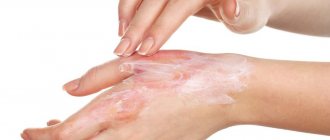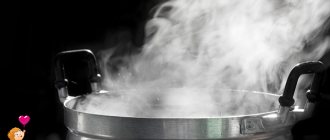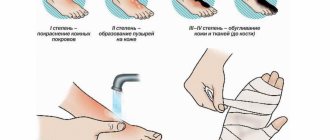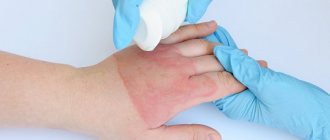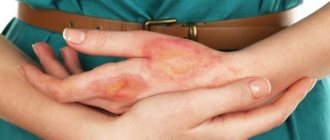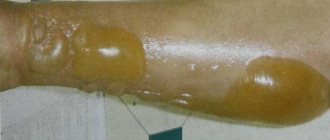A burn is one of the types of injuries in which damage and destruction of the skin and soft tissue occurs. The reasons may be different: high temperature, electric current, aggressive chemical compounds, sun rays. A person can receive such an injury anywhere: at home and at work, on vacation and in any other place.
The number of deaths and people with serious injuries could be reduced if everyone knew how to provide first aid in a timely and professional manner. Specialists from the multidisciplinary medical center KIT recommend that you familiarize yourself with the rules for providing care for burns. We advise you to follow safety rules and remember well what needs to be done in such cases and what is strictly prohibited.
Types of chemical burns
Taking into account the characteristics of the damaging substance, the following types of damage are distinguished:
- Acidic.
When it comes into contact with the skin, the acid causes the protein to coagulate. As the protein breaks down, it forms a dense crust that prevents the substance from penetrating deep into the tissue. Therefore, such burns are usually shallow. - Alkaline.
Improper handling of caustic soda, quicklime, and ammonia leads to serious consequences. The aggressive substance corrodes tissue, causing deep damage. Such wounds heal more slowly than other burns. - Burns from heavy metal salts.
Less dangerous compared to previous species. Damage is limited to the outer layer of the skin. - Phosphoric.
Upon contact with the skin, the substance ignites, leaving behind a deep wound.
In the absence of first medical aid, the substance continues to destroy the integrity of the integument. Removing the chemical from the skin is not enough to stop the reaction; only inactivation will help.
Consequences
If the burn was caused by an acid or alkali, a crust forms in its place, which has its own name - a scab.
Alkalies in contact with skin are much more dangerous than acids, because... they quickly penetrate into the deep layers of tissue, causing serious damage.
- If the burn was caused by alkali, the color of the scab is whitish, without clear boundaries, with an imperceptible transition to adjacent healthy tissue. The texture of the scab is soft and loose; it hardens much later.
- When exposed to acid, the scab looks different - from dense, hard and dry. The border is clearly defined, the transition to healthy areas of the skin is visible to the naked eye. Typically, such injuries are superficial, which speeds up recovery.
The color of the tissue in the affected area depends on the type of chemical:
- When sulfuric acid comes into contact with the skin, the burn is initially white, then turns gray or brown.
- When exposed to nitrogen acid, the burn will be light yellow, with a greenish or brown tint.
- When skin comes into contact with hydrochloric acid, a yellow burn is formed;
- Acetic acid leaves off-white burns when it comes into contact with the skin;
- After carbolic acid, white traces remain, which subsequently become brown;
- Concentrated hydrogen peroxide leaves dirty-gray burns.
It is useful to study and remember the differences in burns by color so that in a critical situation you can quickly determine the type of composition that burned the skin. This will help minimize harm or even save lives.
When chemicals get on the skin, their effect continues for some time after contact has been stopped (the wound is washed, a bandage is applied).
This is due to the peculiarities of the functioning of our tissues - the absorption of the substance does not stop instantly, which makes it much more difficult to determine the degree of the burn.
Sometimes the substance continues to act for several hours or even days - so it is very difficult to immediately draw conclusions about the depth of the damage. As a rule, it is possible to accurately determine the extent of the burn only 1-1.5 weeks after the injury - by this time the scab begins to suppurate, which is one of the parameters when determining the depth of the damage.
The severity of a burn from contact with chemicals depends on two key characteristics - depth and area. Chemical burns themselves are usually deep, and if they are also large, this aggravates the situation.
Classification by severity
Depending on the severity of the injury, there are three degrees of burns. The first is diagnosed with superficial damage to the skin.
Such burns are formed by short-term or weak contact of the substance with the cover. Accompanied by mild swelling, redness and burning. The wound heals in 3-5 days. There is no scar left.
Blisters filled with clear liquid indicate a second-degree burn.
Pain and redness are more pronounced. It takes about two weeks for tissue recovery after such a lesion. The threat of infection increases.
The third degree is the most severe.
Characterized by damage to the lower layers of the skin. The wound heals after 1-2 months, leaving behind a rough scar.
Burns of mucous membranes are classified in a similar way. In such cases, diagnosing the severity of the lesion becomes more difficult and requires medical assistance.
Possible complications
Complications of alkali burns can be general and local. General ones develop in case of extensive and deep damage:
- Burn hypovolemic shock due to fluid loss,
- Poor circulation due to blood thickening, thrombosis,
- Impaired liver and kidney function associated with intoxication,
- Sepsis due to infection of extensive burn surfaces.
Local consequences can be in the form of wound suppuration, prolonged non-healing, the formation of rough keloid scars that limit mobility or are a cosmetic defect.
On the part of the eyes, the most common development is clouding of the cornea - a cataract; with severe burns, the deeper media of the eye are also affected, up to complete loss of vision.
How to provide first aid for a chemical burn
In case of a burn, you need to act immediately, on the spot.
First of all, it is necessary to remove the substance from the skin as quickly as possible. Do not use a napkin, sponge or other materials - even light pressure can cause the agent to penetrate deeper into the tissue. It is better to shake off the powder. Residues should be washed off with water, the duration of the procedure is 15-20 minutes. If the wound is shallow, it is enough to apply a sterile bandage or bandage. In case of serious burns, the victim must be wrapped in a clean sheet, given painkillers and called an ambulance. To reduce the risk of poisoning, you should open the windows and, if possible, take the victim to fresh air.
In some cases, contact with water will only worsen the situation; for example, aluminum compounds may ignite. Therefore, it is initially necessary to find out the details of the incident from the victim.
The extent of the wound depends on how timely first aid was provided for chemical burns.
Treatment of burn wounds at home
If the burn wounds are small and not very deep, then treatment of the burn with alkali can be carried out at home using medications prescribed by a doctor, supplementing them with folk remedies, if possible. You need to visit your doctor regularly and follow his recommendations.
Use of drugs
Alkaline burns are dangerous because infection easily develops in areas of wet necrosis. Therefore, in the acute stage, antibacterial agents are prescribed - antiseptic solutions. They moisten a sterile napkin and change it 2-3 times a day until the wound is completely cleansed and “dried” so that there is no purulent discharge. Solutions of Miramistin and Chlorhexidine work well.
To quickly remove necrotic tissue, Iruksol enzyme ointment is widely used; it dissolves dead areas and has an antiseptic effect. First, the wound is washed with an antiseptic, then ointment is applied for a day.
A cleansed granulating wound needs agents that stimulate the healing process. The most effective ointments are Solcoseryl, Actovegin, and if there is still a lot of discharge, use a Peloidin solution prepared on the basis of medicinal mud. Wound dressings are done once a day.
Traditional methods
Among the folk methods for burns, the application of all kinds of gruels and mixtures of grated vegetables, fats and oils should be excluded. Preference should be given to products that undergo heat treatment. You can treat alkali burns with decoctions and herbal infusions:
- daisies,
- Calendula,
- mint,
- Hop cones,
- St. John's wort.
The possibility of using any folk medicine for burns must be agreed with a doctor.
You can prepare an herbal mixture by taking equal parts of each component, brew 1 tablespoon of the mixture with a glass of boiling water, it is better to hold it in a water bath for 10-15 minutes, then strain into a boiled bowl and cool. Apply to the wound on a moistened sterile napkin 2-3 times a day.
Freshly squeezed juice of aloe or Kalanchoe leaves gives a good antibacterial and wound-healing effect.
It is carefully squeezed into a clean container, moistened with a sterile napkin, and applied to the wound daily. A decoction of oak bark and strong tea brewing will help relieve pain and itching around the wound. Prepare at the rate of 1 tablespoon per 1 glass of boiling water, leave on low heat for 5 minutes. Apply several times a day for half an hour.
Precautions and prevention measures
To protect yourself from chemical burns, you should follow simple rules.
When working with aggressive substances, you must wear personal protective equipment, such as gloves, goggles and a respirator. Chemicals should be stored in tightly closed containers (labeled) away from food and places where children can reach them. After use, ventilate the room. It is dangerous to mix substances if you are not sure of the consequences of their combination.
Added: 10/19/2021
What happens if you drink lye?
A person who drinks alkali will experience the following symptoms:
- Mouth burn. Soft tissues swell and turn red. The man is suffering from severe pain. Gradually, swelling turns into ulcers;
- Thirst appears. There is a metallic taste in the mouth for a long time;
- Pain in the chest area. Its intensity depends on the concentration of the alkali drunk;
- Severe vomiting interspersed with blood. This is due to the fact that alkali damages internal blood vessels;
- Risk of asphyxia due to intense vomiting or deformed esophageal tissue;
- State of shock. If the concentration of alkali is high, then the pain symptom leads to a person’s frenzy, he stops thinking rationally and sometimes is not even able to call doctors;
- Some time after the initial symptoms, bloody diarrhea occurs.
Analyzing cases of alkali poisoning, doctors came to the conclusion that the stomach may not be affected at all. After all, when the alkali you drink interacts with the acidic environment of the stomach, the former is neutralized .
But if the concentration of the substance is high enough, then there is a possibility of perforation of the esophagus, that is, the formation of a hole in it.
Even the use of small doses of alkaline solutions is fraught with complications, although at first a person may get away with mild symptoms. Therefore, no self-medication, only prompt consultation with a doctor.
The specialist must also be informed of the name of the substance that caused the shipment. This will help you immediately choose a course of treatment and not waste time on additional examinations.
Victims who have fallen into a state of shock often make a number of dangerous mistakes:
- Induce vomiting . It increases the risk of damage to the esophagus several times. After all, the alkaline liquid from the stomach will again go back along the same path that it got inside;
- They use laxatives . Only a doctor can decide how appropriate a particular detoxification method is;
- Drink a solution of citric acid . This mistake is due to the fact that people have a general understanding of neutralizing an alkali with an acid. But what is relevant for household use will not help in any way with poisoning. An acidic solution can only give additional stress to the poisoned body.
How to wash off lye?
In everyday life, people often get burns from quicklime. It is just an alkali. Many victims in this case instinctively try to wash off the reagent with plain water. Not only will this not help, but it will further enhance the effect of the alkali.
If quicklime gets on your skin, remove it with a dry cloth. Then the damaged skin is lubricated with vegetable oil. If the inflammation is severe and causes acute pain, then you should consult a doctor.
Other types of alkalis should be washed off with cool water . To effectively get rid of the reagent, you need to keep the damaged skin under the stream for about 15 minutes.
Do not dry your skin with a towel. Loose scabs may have time to form on the skin, so friction causes the skin to become even more injured.
Skin restoration
After a burn, a blister containing a colorless liquid may form on the skin. Its proper treatment will help avoid an inflammatory and purulent reaction. Under the neoplasm there will be a renewed skin layer; after 8-10 days, the damaged part will dry out and fall off.
In place of the blister, new skin will appear in the form of a pink spot. The renewed skin area is usually very sensitive, so it is recommended to treat it with special creams and ointments that promote effective and safe recovery.
Failure to provide first aid in a timely manner can lead to disappointing consequences. An infection will appear at the burn site, the resulting blister will become inflamed and begin to fester. The phenomenon usually entails fever, poor health, chills and weakness. The wound will heal slowly and recovery may take too long. In order to avoid serious complications, you should not hesitate, you need to urgently contact a specialist, who, in turn, will conduct tests and prescribe the correct treatment.
